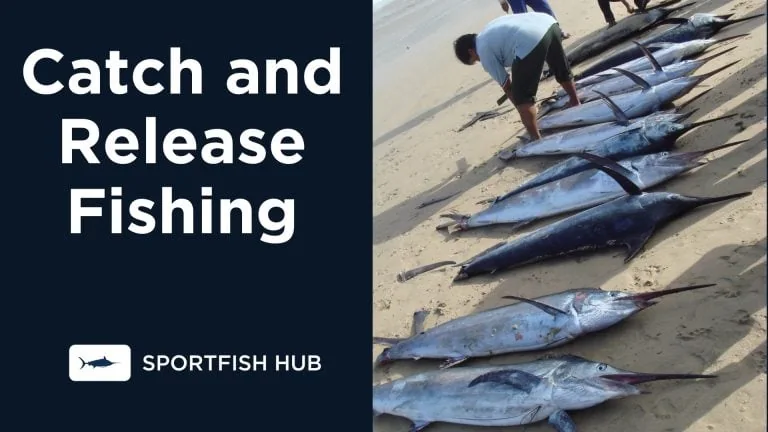Are you a fishing enthusiast who’s concerned about the impact of your hobby on the environment? If so, catch-and-release fishing might be the perfect solution for you.
Catch-and-release fishing is a practice where fish are caught and then returned to the water alive, minimizing the impact on fish populations and promoting sustainable fishing.
Table of Contents
- Key Takeaways
- A Detailed Explanation of Catch and Release Fishing
- Choosing The Right Gear
- Debates And Controversies Surrounding Catch And Release Fishing
- Pain Experienced By Released Fish
- Injury And Mortality Rates Of Released Fish
- What percentage of fish survive catch and release?
- How Ethical is Catch and Release Fishing?
- FAQ
- Conclusion
Key Takeaways
- Catch-and-release fishing is a conservation-focused technique where caught fish are promptly returned to the water, helping to prevent overharvesting and improve native fish populations.
- This sustainable practice allows fish to remain in their natural habitat, contributing to species preservation and maintaining ecological balance.
- Anglers can enhance their catch-and-release fishing practices by choosing the right gear, handling fish with care, releasing them at the proper depth, and resuscitating exhausted fish when necessary.
A Detailed Explanation of Catch and Release Fishing
Catch-and-release fishing is more than just a method of fishing; it’s a philosophy that prioritizes conservation and respect for aquatic life.
The Philosophy Behind Catch and Release
The primary goal of catch and release is to allow the fish to live on after the catch, contributing to the sustainability of fish populations.
This practice is particularly important in areas where fish are at risk due to overfishing or environmental changes. By releasing the fish back into the water, anglers can enjoy their hobby without depleting the aquatic ecosystem.
The Impact on Fish Populations
Catch and release-fishing has a significant impact on fish populations.
When practiced correctly, it can help maintain a healthy balance in aquatic ecosystems because overfishing can lead to a decline in fish populations, disrupting the balance of the ecosystem.
Catch and release provides a solution to this problem, allowing anglers to enjoy fishing without contributing to the decline of fish species.
How to Practice Catch and Release Correctly
Practicing catch and release correctly is crucial to ensure the survival of the fish after it’s returned to the water. This involves using the right equipment, handling the fish properly, and minimizing the time the fish spends out of the water. We’ll delve into these aspects in more detail later in the article.
Choosing The Right Gear
To ensure a successful catch-and-release fishing experience while also promoting conservation, it is crucial for recreational anglers interested in conservation to choose the right gear. Here are some guidelines to follow:
- Select appropriate fishing tackle: Opt for lightweight and sensitive fishing rods that provide better control and minimize stress on the fish. Use reels with smooth drag systems to avoid extra pressure during fights.
- Use barbless hooks: Barbless hooks are easier to remove from fish, reducing injury and minimizing handling time. This increases the chances of a successful release.
- Go for non-stainless-steel hooks: Stainless steel hooks take longer to degrade if left in a fish’s mouth or digestive tract. Using non-stainless-steel hooks helps reduce harm if a fish accidentally swallows the bait.
- Choose the right line strength: Use adequate line strength based on the target species you intend to catch. Lighter lines can help prevent excessive strain on the fish during retrieval.
- Avoid lead sinkers: Lead sinkers pose significant risks to aquatic environments and wildlife due to their toxicity when ingested. Replace them with sinkers made from alternative materials such as tungsten or bismuth.
- Consider using circle hooks: Circle hooks have a higher chance of hooking a fish in the mouth rather than in vital organs, leading to fewer injuries and increased survival rates upon release.
- Practice proper knot tying: Ensure your knots are secure, reliable, and unlikely to break during a fight with a fish. This reduces the risk of losing equipment or injuring fish due to broken lines or tangled gear.
- Be mindful of artificial lures: Carefully choose lures that resemble natural prey species in terms of size and coloration to increase your chances of catching target species while minimizing potential harm caused by unnecessary strikes from non-target species.
Handling Fish With Care
Handling fish with care is crucial when practicing catch-and-release fishing. By following these steps, you can minimize stress and injury to the fish:
- Wet your hands: Wetting your hands before handling a fish helps protect their delicate slime coating, which is essential for their health. Avoid using dry hands or gloves, as they can remove this protective layer.
- Minimize air exposure: Limiting the amount of time a fish spends out of water is crucial. If you need to take a photo, ensure everything is ready beforehand so the fish can be released quickly. Prolonged air exposure can cause stress and damage to the gills.
- Support the weight properly: When lifting a fish out of the water, provide adequate support by cradling it gently with both hands. Avoid squeezing or applying too much pressure, as this can harm internal organs or damage scales.
- Avoid touching sensitive areas: Fish have sensitive areas like their eyes, gills, and mouths that should be avoided when handling. Touching these areas can cause injury or stress to the fish.
- Keep them in water during the removal of hooks: Whenever possible, keep the fish in water while removing the hook. Use forceps or pliers to carefully remove the hook without causing any additional damage.
- Be mindful of exhaustion: Fish that have been fighting on a line may become exhausted when brought close to shore or boat. Take extra care in handling these tired fish by providing gentle support and allowing them time to recover in the water before releasing.
Releasing Fish At The Proper Depth
To ensure the survival and well-being of fish during catch-and-release fishing, it is crucial to release them at the proper depth. Here are some tips for releasing fish effectively:
- Understanding species-specific needs: Different fish species have different preferences when it comes to water depth. Research and understand the ideal conditions for the specific species you are targeting.
- Avoid shallow areas: Shallow areas can be risky for released fish as they may face increased predation or encounter other stressors. Release them in deeper waters where they can quickly find suitable hiding spots and recover from any physiological stress caused by capture.
- Consider water temperature: Fish often seek out specific temperature zones within a body of water. Releasing them at a similar temperature range can increase their chances of survival and aid in their acclimatization process.
- Minimize handling time: Reduce handling time as much as possible while releasing the fish at the right depth. Unhooking, measuring, weighing, or photographing should be done quickly and efficiently to minimize stress on the fish.
- Maintain control during release: Gently support the fish near its tail and belly, ensuring it is upright before releasing it into the water. If necessary, gently move it back and forth to encourage oxygen exchange through its gills before letting go.
Resuscitating Exhausted Fish
Resuscitating exhausted fish is a vital step in ensuring their survival after catch-and-release fishing. Here are some effective techniques to follow:
- Handle with care: When handling an exhausted fish, be gentle to avoid further stress or injury. Wet your hands before touching the fish to protect its delicate slime layer.
- Revive in the water: Submerge the fish gently in the water, cradling it until it can swim away on its own. Always release the fish headfirst to promote proper swimming orientation.
- Use proper resuscitation techniques: If the fish appears lethargic or struggles to swim, you can aid in its recovery by gently moving it back and forth in the water, helping water flow over its gills.
- Consider using a recovery device: In certain situations, such as deepwater catches or when a fish is severely exhausted, using a specialized recovery device like a venting tool or descending device can help enhance survival rates.
- Minimize air exposure: Limiting a fish’s time out of the water reduces stress levels and improves its chances of survival. Take quick photos and remove hooks efficiently.
Read Also: Is Marlin Fishing Catch and Release?
Debates And Controversies Surrounding Catch And Release Fishing
Catch and release fishing has sparked debates and controversies, with concerns raised about the pain experienced by released fish, injury, and mortality rates, as well as differing perspectives on the ethical aspects of this practice.
Pain Experienced By Released Fish
When fish are caught and released, they can experience pain due to the stress and physical trauma of being hooked. While it’s difficult to understand the extent of this painfully, studies, have shown that fish do possess nerve endings sensitive to pain.
However, it’s important to note that the duration and severity of this pain can vary among species. Some studies suggest that larger fish may experience more prolonged discomfort compared to smaller ones.
To mitigate the potential pain experienced by released fish, anglers can take several steps. Firstly, using barbless hooks or de-barbing hooks before fishing can make hook removal quicker and less painful for the fish.
Secondly, minimizing handling time by keeping the fish in the water as much as possible reduces stress levels significantly.
Additionally, angling methods like “play-reel-release” allow for a swifter landing process while also diminishing exhaustion caused by long fights. This method involves releasing tension on the line once a hooked fish makes its initial run before reeling it back in gently.
Injury And Mortality Rates Of Released Fish
When practicing catch-and-release fishing, it is essential to understand the potential injury and mortality rates of released fish. While the goal is to ensure their survival, studies have shown that some fish do not survive the experience.
What percentage of fish survive catch and release?
The exact numbers vary depending on the species and environmental factors, but it is estimated that between 5% to 30% of released fish may die as a result.
The stress caused by angling can lead to physical injuries such as bleeding or damaged fins, making it challenging for fish to recover once released. Additionally, physiological stress from being hooked can affect their immune system and make them more susceptible to diseases or predators.
It’s important for anglers engaging in catch-and-release fishing to be mindful of these risks and take every precaution necessary to minimize harm to the fish they handle.
By using proper handling techniques such as wetting hands before touching the fish, supporting their weight with both hands, avoiding squeezing or bending them unnaturally, and releasing them quickly at an appropriate depth, anglers can significantly increase the chances of survival for released fish.
How Ethical is Catch and Release Fishing?
Catch-and-release fishing generates plenty of debate regarding its ethical implications, with proponents highlighting responsible enjoyment and fish population preservation, while critics express concerns about potential harm and question the morality of subjecting fish to stress for human pleasure.
While studies show that fish do experience some physiological stress when caught, these effects vary depending on the species and circumstances.
FAQ
Do fish feel pain the same way as humans?
No, fish do not feel pain the same way humans do. They lack the brain structures that humans use to process pain. However, they can respond to harmful stimuli.
Do fish heel after being hooked?
Yes, fish can heal after being hooked. The healing process depends on the location and severity of the injury. Proper catch and release techniques can minimize harm.
How long can fish live out of water for catch and release?
The survival time varies among species, but generally, fish should be returned to the water within a few minutes. The less time fish spend out of the water, the higher their survival chances.
Should you release dead fish?
No, if a fish is already dead, it should not be released back into the water. Dead fish can spread diseases or disrupt the ecosystem.
Conclusion
In conclusion, catch-and-release fishing is a crucial conservation practice that benefits both anglers and fish populations. By releasing fish back into their natural habitat, we can prevent overharvesting, improve native fish populations, and allow for reproduction in the ecosystem.
With responsible angling techniques, such as handling fish with care and releasing them at the proper depth, we can ensure the survival of these beautiful creatures for future generations to enjoy.












